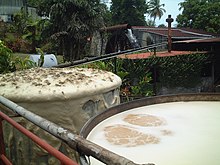Rhum agricole (French pronunciation: [ʁɔm aɡʁikɔl]) is the French term for sugarcane juice rum, a style of rum originally distilled in the French Caribbean islands from freshly squeezed sugarcane juice rather than molasses. Rhum is the term that typically distinguishes it in French-speaking locales from the rum made with molasses in other parts of the West Indies (Rum, Ron).

Overview
editCane juice rum mostly comes from Haiti, Martinique, and the Guadeloupe islands of Marie-Galante, Grande-Terre, and Basse-Terre, but is made throughout the Caribbean, including on Trinidad, Panama, the Dominican Republic and Grenada, in the Indian Ocean on Mauritius and Réunion Island, and in the Pacific Ocean on the islands of Hawaii and in Vanuatu.
Most rum is made from molasses, a byproduct of sugar refining. When France began to make sugar from sugar beets around 1811, sugar prices dropped and the debt-ridden sugar factories in the French Caribbean could not survive solely on sugar production. Fresh cane juice was now available for fermenting and distilling into rum.[1]
Martinican producers of cane-juice rums made entirely in Martinique and meeting certain production standards are entitled under French law to the appellation d'origine contrôlée (French protected designation of origin) "AOC Martinique Rhum Agricole."[2] This designation is unique to Martinique and does not define the category of cane juice rum or rhum agricole.
In Martinique, AOC labeled cane juice rums are usually distilled to 70% alcohol (140 proof in the U.S.) and then watered down to 40–55% (80–110 proof) when bottled. It may be aged as little as a few months (3 months at least for AOC Martinique Rhum agricole) or up to a few years. After three years of aging in oak barrels, it may be called "rhum vieux," or "old rum".[3]
Eight distilleries in Martinique produce rhum agricole. They include:
- La Mauny in Rivière-Pilote which also produces rums Trois Rivières,
- Rhum J.M in Macouba (produces rums J.M and Clément),
- Depaz in Saint-Pierre,
- Saint-James in Sainte-Marie (distills Saint James, Baie des Trésors, Hardy...),
- Le Simon in Le François which distills rums HSE and Braud & Quennesson.[4]
- La Favorite in Le Lamentin
- Neisson in Le Carbet
- HBS in Grand Rivière
The French multi liquor product La Martiniquaise was founded by Jean Cayard in 1934 as an importer of Martinique rums and is now the second largest liquor company in France. La Martiniquaise currently led by Jean-Pierre Cayard owns Distillerie Saint-James.
The archipelago of Guadeloupe is often listed as one of the best rum destinations,[5] where the rhum is appreciated for its signature flavor. There are nine distilleries in the Guadeloupe Islands and centuries-old traditions in distillation are still used to produce multi-awarded labels. In Basse-Terre you will find Domaine de Severin, Distillerie Bologne, Distillerie Longueteau and Distillerie Reimonenq. Two attract tourists Distillerie Bologne as having been the home of the family of the Chevalier de Saint-Georges, Distillerie Reimonenq is (where the Musée du Rhum[6] is located). In Grande-Terre there is Distillerie Damoiseau and in Marie-Galante there are Distillerie Bellevue, Distillerie Bielle and Distillerie Poisson (also known as Rhum du Père LaBat).
The rest of the Caribbean produces cane juice rums of varying ages. Most notable are the Barbancourt rums of Haiti which are aged to four, eight and fifteen years. There are five hundred village cottage industry producers of clairin. A form of cane juice rum first appeared in Brazil where it is called Cachaça.
With the burgeoning craft distilling scene, new world styles of rhum agricole are appearing. In Australia, Husk Distillers use local cane varieties, paddock to bottle production and a pot still batch distillation to create a unique Australian expression. Other new world Rhum Agricole distilleries include Chalong Bay and Lamai Distilleries in Thailand and Chamarel in Mauritius. With the closure of Hawaii's crystalline sugar producing mills, some artisanal distilleries have opened which continue production of cane for rhum agricole.
See also
editReferences
edit- ^ "History & origins". rhum-agricole.net. Archived from the original on 24 July 2011. Retrieved 24 October 2010.
- ^ "AOC Rhum Martinique description". Rhum Agricole. Archived from the original on 24 July 2011. Retrieved 18 February 2011.
- ^ "Caribbean Spirits : Rhum Agricole". Caribbean-spirits.com. Archived from the original on 4 July 2010. Retrieved 28 June 2010.
- ^ "All Roads Lead to Rum in Martinique". Alyssa Writes. 27 April 2013. Archived from the original on 19 February 2019. Retrieved 20 November 2018.
- ^ "The Best Rum Destinations". Caribbean Journal. 15 April 2014. Archived from the original on 25 May 2015. Retrieved 19 June 2015.
- ^ "Musée du Rhum". musee-du-rhum.fr. Archived from the original on 12 May 2015. Retrieved 19 June 2015.
External links
edit- Rhum Agricole at caribbeanspirits.com
- Rhum Agricole at cocktailatlas.com
- Descriptions of Rhum Agricole and Brazilian Cachaca